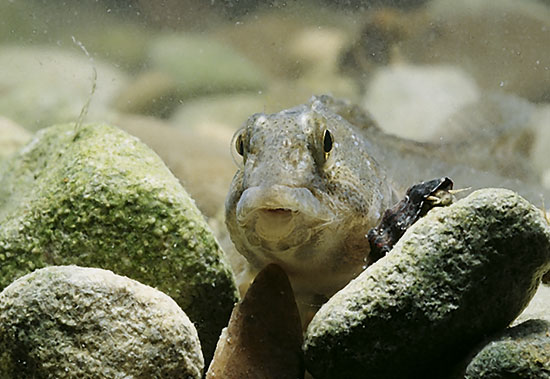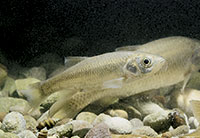 © A. AguilellaSalaria fluviatilis, freshwater blenny. © A. AguilellaSalaria fluviatilis, freshwater blenny. |
||
|
Which fish are to be found in the Mediterranean rivers? A rich and diverse ichthyofauna has developed in our rivers with a great many species, mainly comprising cyprinids, of the genera Barbus, Chondrostoma and Squalius. Their conservation is very difficult, due to both the competition they face with the numerous fish species that have been introduced from elsewhere and also the great environmental impact suffered by the Mediterranean rivers caused by strong urbanistic pressures and high levels of water consumption throughout the Mediterranean region. Biological communities respond to the factors that shape their habitat, to the environmental factors in which they live, to the climatic factors they endure, to the biological factors related to the species that comprise them, etc. In the case of freshwater fish, as in other aquatic organisms, we must also add the factors that regulate the quantity and quality of water. Moreover, we must also take into account the long-term relationship of these factors with the geological history of their territory. The Iberian Peninsula separation from Europe – by the Pyrenees – and Africa – by the Gibraltar strait – has created a very rich and very diverse freshwater ichthyofauna, very different from the one found in the rest of Europe, which has evolved independently for a long time, resulting a high number of endemisms. All along this historical process, river channels have been apart for a long time, which is reflected on the fact that many fish species are found in very few river channels. The result of this particular geological history is a Mediterranean ichthyofauna with a high number of autochthonous species (27 fish species) as well as a high number of endemisms (13 species, which adds up to almost 50% of the autochthonous species). The high number of introduced species (up to 17,46% of the 44 species that can be found in Mediterranean rivers) is worthwhile mentioning – they have become one of the biggest problems for Mediterranean ichthyofauna conservation. Most of these species – whether autochthonous or introduced – are Cyprinids, which is also the most widespread family in all rivers at the Peninsula. If we talk about autochthonous fish, Cyprinids belong to the Barbus genus (five species), Chondrostoma (five species) and Squalius (two species). Among barbels we can make a distinction between species adapted to lower and middle stretches of the river (B. graellsii, B. guiraonis and B. sclateri), which can reach up to 50 cm; and a second group that can be found in higher stretches of the river, which are smaller (B. haasi and B. meridionalis). Except the latter, the Mediterranean barbel, the other four barbel fish are endemic. All the species of the genus Chondrostoma are endemic and three of them are exclusively Mediterranean (Ch. arrigonis, Ch. miegii and Ch. turiense). Finally, within the Squalius genus we find a larger species (up to 60 cm) distributed throughout Central Europe and the northern Mediterranean basins, the S. cephalus; while the S. pyrenaicus, smaller in size (up to 25 cm), is located in southern rivers of both the Mediterranean and the Atlantic watersheds. The remaining families are poorly represented with one or two autochthonous species. For salmonids, of which the brown trout (Salmo trutta) is the only autochthonous species, though distributed throughout the European continent, the Mediterranean populations are genetically distinct from the rest. This is why their conservation is of considerable value, in relation to the management of their fishing based on continuous repopulations with trouts from other population origins. Although unrelated taxonomically, the Cobitidae (Cobitis calderoni and C. paludica), the Balitoridae (Barbatula barbatula), the Gasterosteidae (Gasterosteus gymnurus) and the Blenniidae (Salaria fluviatilis) are small-size species, up to 10 to 15 cm, with small distributions because they have strict environmental requirements and are very sensitive to water pollution. We find a small number of migratory species (Petromyzon marinus, Acipenser sturio, Alosa fallax and Anguilla anguilla) with a dwindling presence because of the degradation and pollution of the lower reaches that primarily affects large Mediterranean rivers, mainly the Ebro. In this description of river ichthyofauna we still have to mention two freshwater species of small size, between 5 and 8 cm, typical of coastal lagoons: the Spanish toothcarp (Aphanius iberus) and Valencia toothcarp (Valencia hispanica) endemic to the Mediterranean coast and which are currently found in a small number of locations. Speaking of exotic fish, we find a great diversity both from the taxonomic point of view and from their origin and year of introduction. Regarding the ecological impacts they may cause, we can differentiate between predators and non-predators. Most predators (Esox lucius, Silurus glanis, Micropterus salmoides, Perca fluviatilis, Sander lucioperca, etc.) have been introduced because of sport fishing and the greatest impact caused is the threat to the survival of native species. In the case of non-predators (Alburnus alburnus, Scardinius erythropthalmus, Ameiurus melas, Gambusia holbrooki, Lepomis gibbosus, etc.) they can compete successfully with native fish in degraded environments, due to their greater reproductive capacity, to their more generalist nature or to their greater adaptive capacity… And to complete the changes in fish communities we find translocations of autochthone species to rivers outside their natural distribution. In any case, this exchange of fishes is due to the interconnection between river basins, such as in the transfer of water between the Tajo and the Segura, which caused the arrival of the goldfish, Carasius auratus, and the gudgeon, Gobio gobio, to the Segura; and of the nase, Chondrostoma polylepis, to the Júcar and the Segura. In situations of contact between closely related species hybridization is added as a risk factor, as has occurred between the nose and the Chondrostoma arrigonis nase in the Júcar. The new transfers set out in the PHN (Spanish national hydrological plan) are a serious threat to the conservation of the integrity of fish communities that have been isolated from each other for millions of years. Today there are major impacts associated with human activities. The channelization of rivers, the building of dams and canals, water pollution, the destruction of riparian forest, urban pressure, aggressive agricultural and forestry practices… produce irreversible changes which in Mediterranean rivers, with highly variable flow and scarcity of water in many channels, still represent a greater environmental pressure. This great transformation of rivers results in the fact that only one species of Mediterranean fish fauna can be considered as non-threatened, according to the technical criteria set by the International Union for Conservation of Nature. Over 80% of autochthonous species are under significant risk of extinction in the near future if the aforementioned factors persist. The high biological value of Mediterranean rivers, increased in the case of fish due to their high degree of endemicity, makes it necessary and a top priority to develop a plan to protect our fish and our rivers in order to improve their poor state of conservation. |
 Chondrostoma miegii, Ebro nase. Photo: A. Aguilella Barbus haasi, red-tailed barbel. Barbus graellsii, Ebro barbel. Gobio gobio, gudgeon. |
|
TaBLE WITH DATA OF MEDITERRANEAN FISH SPECIES
| Family | Scientific name | English name | Species | Conservation status | Main Mediterranean basins where it is located |
| Petromyzontidae | Petromyzon marinus | Sea lamprey | Autochthonous | Vulnerable | Ebro |
| Acipenseridae | Acipenser sturio | Sturgeon | Autochthonous | Critically endangered | Ebro, Turia, Júcar |
| Clupeidae | Alosa fallax | Twait shad | Autochthonous | Vulnerable | Ebro, Fluvià |
| Anguillidae | Anguilla anguilla | Eel | Autochthonous | Vulnerable | In all |
| Salmonidae | Oncorhynchus mykiss | Rainbow trout | Introduced | — | Llobregat, Ebro, Palancia, Turia, Júcar, Segura |
| Salmo trutta | Brown trout | Autochthonous | Vulnerable | En la majoria de capçaleres | |
| Esocidae | Esox lucius | Pike | Introduced | — | Ebro, Júcar |
| Ciprinidae | Abramis bjoerkna | Silver bream | Introduced | — | Local distribution |
| Alburnus alburnus | Bleak | Introduced | — | Ebro, Turia, Júcar | |
| Barbus graellsii | Ebro barbel | Endemic | At lower risk | Ter, Llobregat, Ebro | |
| Barbus guiraonis | Valencia barbel | Endemic | Vulnerable | Palancia, Turia, Júcar | |
| Barbus haasi | Red-tailed barbel | Endemic | Vulnerable | Llobregat, Ebro, Millars, Palancia, Turia, Júcar | |
| Barbus meridionalis | Mediterranean barbel | Autochthonous | Vulnerable | Muga, Fluvià, Ter, Besòs | |
| Barbus sclateri | Andalusian barbel | Endemic | At lower risk | Segura | |
| Carassius auratus | Goldfish | Introduced | — | Ebro, Turia, Júcar | |
| Chondrostoma arcasii | Iberian roach | Endemic | Vulnerable | Francolí, Ebro, Palancia, Millars, Turia, Júcar | |
| Chondrostroma arrigonis | Júcar nase | Endemic | Threatened | Júcar | |
| Chondrostroma miegii | Ebro nase | Endemic | At lower risk | Llobregat, Ebro | |
| Chondrostroma polylepis | Iberian nase | Endemic | At lower risk | Júcar, Segura | |
| Chondrostroma turiense | Turia nase | Endemic | Threatened | Millars, Turia | |
| Cyprinus carpio | Common carp | Introduced | — | In all | |
| Gobio gobio | Gudgeon | Autochthonous | Vulnerable | Ebro, Turia, Júcar, Segura | |
| Phoxinus phoxinus | Common minnow | Autochthonous | Vulnerable | Muga, Ebro | |
| Rutilus rutilus | Roach | Introduced | — | Local distribution | |
| Scardinius erythrophthalmus | Common rudd | Introduced | — | Muga, Llobregat, Ebro | |
| Squalius cephalus | European chub | Autochthonous | Vulnerable | Muga, Ter Llobregat, Ebro | |
| Squalius pyrenaicus | Southern Iberian chub | Autochthonous | Vulnerable | Ebro, Millars, Turia, Júcar, Segura | |
| Tinca tinca | Tench | Autochthonous | Non-threatened | Local distribution | |
| Cobitidae | Cobitis calderoni | Northern Iberian spined-loach | Endemic | Vulnerable | Ebro |
| Cobitis paludica | Southern Iberian spined-loach | Endemic | Vulnerable | Millars, Turia, Júcar, Bullent | |
| Balitoridae | Barbatula barbatula | Stone loach | Autochthonous | Vulnerable | Ter, Ebro |
| Ictaluridae | Ameiurus melas | Black bullhead | Introduced | — | Local distribution |
| Ictalurus punctatus | Channel catfish | Introduced | — | Local distribution | |
| Siluridae | Silurus glanis | Wels catfish | Introduced | — | Ebro |
| Cyprinidontidae | Aphanius iberus | Spanish toothcarp | Endemic | Threatened | Coast |
| Valenciidae | Valencia hispanica | Valencia toothcarp | Endemic | Threatened | Coast |
| Poeciliidae | Gambusia holbrooki | Eastern mosquitofish | Introduced | — | Local distribution |
| Poecilia reticulata | Guppy | Introduced | — | Millars | |
| Gasterosteidae | Gasterosteus gymnurus | Three-spined stickleback | Autochthonous | Threatened | Muga, Fluvià, coast |
| Blenniidae | Salaria fluviatilis | Freshwater blenny | Autochthonous | Threatened | Fluvià, Ebro, Júcar |
| Centrarchidae | Lepomis gibbosus | Pumpkinseed | Introduced | — | Local distribution |
| Micropterus salmoides | Largemouth bass | Introduced | — | Local distribution | |
| Percidae | Perca fluviatilis | European perch | Introduced | — | Local distribution |
| Sander lucioperca | Pike-perch | Introduced | — | Muga, Ebro |








